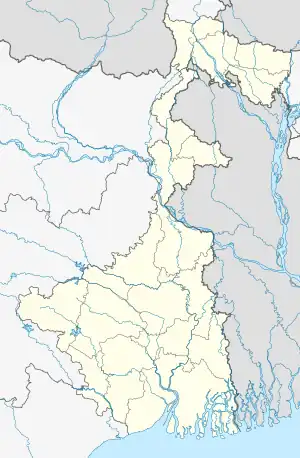Manigram | |
|---|---|
Village | |
 Manigram Location in West Bengal, India  Manigram Manigram (India) | |
| Coordinates: 24°21′13″N 88°06′51″E / 24.3537°N 88.1142°E | |
| Country | |
| State | West Bengal |
| District | Murshidabad |
| Elevation | 35 m (115 ft) |
| Population (2011) | |
| • Total | 4,162 |
| Languages | |
| • Official | Bengali, English |
| Time zone | UTC+5:30 (IST) |
| PIN | 742237 (Manigram) |
| Telephone/STD code | 03463 |
| Lok Sabha constituency | Jangipur |
| Vidhan Sabha constituency | Sagardighi |
| Website | murshidabad |
Manigram (also spelled Monigram) is a village and a gram panchayat in the Sagardighi CD block in the Jangipur subdivision of Murshidabad district in the state of West Bengal, India.
Geography
M: municipal town, CT: census town, R: rural/ urban centre, F: Facility
Abbreviation- TPS: Thermal Power Station, AMU: Aligarh Muslim University
Owing to space constraints in the small map, the actual locations in a larger map may vary slightly
Location
Manigram is located at 24°21′13″N 88°06′51″E / 24.3537°N 88.1142°E.
Villages in Monigram gram panchayat are: Arazi Balarambati, Balarambati, Bhumihar, Chandpara, Dogachhi, Harirampur, Hatpara, Kantanagar, Karala, Kherur, Kismatgadi and Manigram.[1]
Area overview
Jangipur subdivision is crowded with 52 census towns and as such it had to be presented in two location maps. One of the maps can be seen alongside. The subdivision is located in the Rarh region that is spread over from adjoining Santhal Pargana division of Jharkhand. The land is slightly higher in altitude than the surrounding plains and is gently undulating.[2][3] The river Ganges, along with its distributaries, is prominent in both the maps. At the head of the subdivision is the 2,245 m long Farakka Barrage, one of the largest projects of its kind in the country.[4] Murshidabad district shares with Bangladesh a porous international border which is notoriously crime prone (partly shown in this map).[5] The subdivision has two large power plants - the 2,100 MW Farakka Super Thermal Power Station and the 1,600 MW Sagardighi Thermal Power Station.[6][7] According to a 2016 report, there are around 1,000,000 (1 million/ ten lakh) workers engaged in the beedi industry in Jangipur subdivision. 90% are home-based and 70% of the home-based workers are women.[8][9][10] As of 2013, an estimated 2.4 million people reside along the banks of the Ganges alone in Murshidabad district. Severe erosion occurs along the banks.[11]
Note: The two maps present some of the notable locations in the subdivision. All places marked in the maps are linked in the larger full screen maps.
Demographics
According to the 2011 Census of India, Manigram had a total population of 4,162, of which 2,124 (51%) were males and 2,038 (49%) were females. Population in the age range 0–6 years was 535. The total number of literates in Manigram was 2,378 (65.56% of the population over 6 years).[12]
Economy
Sagardighi Thermal Power Station
The Sagardighi Thermal Power Station of West Bengal Power Development Corporation, at Manigram, initially had a capacity of 2 x 300 MW, commissioned in 2008.[13] It was subsequently expanded by 2 x 500 MW. The expansion units were commissioned in 2015[14] and 2017[15]
Transport
Manigram railway station is a situated on the Barharwa-Azimganj-Katwa loop line.[16]
Education
Sagardighi Teachers’ Training College was established at Manigram in 2009. Affiliated with the University of Kalyani, it offers B Ed and D El Ed courses.[17]
Karaiya High School at Manigram was established in 1943 at Manigram. It is a Bengali medium coeducational school teaching from class VI to XII.[18]
Sagardighi Thermal Power School was established at Manigram in 2009. It is a coeducation institution with Bengali and English medium. It has classes from V to XII.[19]
Don Bosco English Medium School Monigram was established at Manigram in 2005.
References
- ↑ "Indian Village Directory". Manigram. Village Info. Retrieved 3 September 2017.
- ↑ "District Census Handbook: Murshidabad, Series 20 Part XII A" (PDF). Physiography, Page 13. Directorate of Census Operations, West Bengal, 2011. Retrieved 24 July 2017.
- ↑ "Murshidabad". Geography. Murshidabad district authorities. Retrieved 24 July 2017.
- ↑ "Farakka Barrage Project". FBP. Retrieved 12 September 2017.
- ↑ "Child labour, illness & lost childhoods, India's tobacco industry". Edge of Humanity Magazine, 27 December 2020. Retrieved 13 July 2021.
- ↑ "Power Generation". Farakka. NTPC. Retrieved 7 August 2016.
- ↑ "The West Bengal Power Development Corporation Limited". Sagardighi Thermal Power Project. WBPDCL. Retrieved 15 August 2017.
- ↑ Kar, Sunirmal. "Child workers in household industry: a study of beedi industry in Murshidabad district of West Bengal" (PDF). Viswa Bharati University thesis, page 5. Shodhganga. Retrieved 28 August 2017.
- ↑ "The 'Poor man's cigarette'". Gurvinder Singh. The Statesman, 22 January 2017. Retrieved 28 August 2017.
- ↑ "Beedi workers of Jangipur hold key". Indrani Dutta. The Hindu, 1 May 2009. Retrieved 28 August 2017.
- ↑ "Types and sources of floods in Murshidabad, West Bengal" (PDF). Swati Mollah. Indian Journal of Applied Research, February 2013. Archived from the original (PDF) on 20 August 2017. Retrieved 5 September 2017.
- ↑ "C.D. Block Wise Primary Census Abstract Data(PCA)". West Bengal – District-wise CD Blocks. Registrar General and Census Commissioner, India. Retrieved 9 September 2017.
- ↑ "The West Bengal Power Development Corporation Limited". Sagardighi Thermal Power Project. WBPDCL. Retrieved 15 August 2017.
- ↑ "Bhel commissions thermal unit in West Bengal". Business Standard, 15 December 2015. Retrieved 15 August 2017.
- ↑ "BHEL commissions 500 MW thermal unit in West Bengal". Business Standard, 16 January 2017. Retrieved 15 August 2017.
- ↑ "53433 Azimganj Barharwa Passenger". Time Table. indiarailinfo. Retrieved 9 August 2017.
- ↑ "Sagaradighi Teachers' Training College". College Admission. Retrieved 3 September 2017.
- ↑ "Karaiya High School". ICBSE. Retrieved 3 September 2017.
- ↑ "Sagardighi Thermal Power School". Acadym. Archived from the original on 21 September 2017. Retrieved 3 September 2017.
